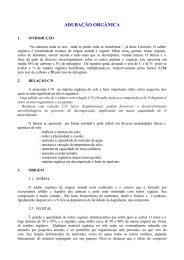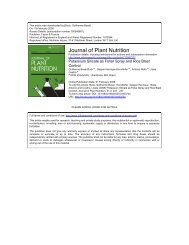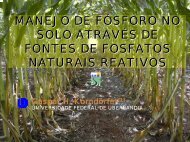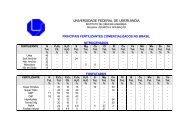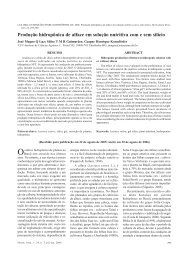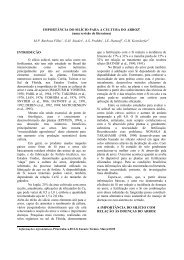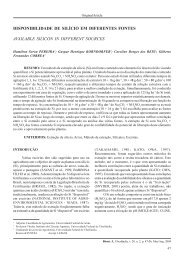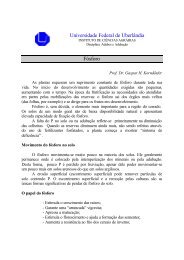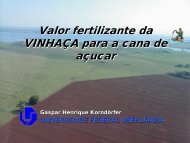Efficiency of Calcium Silicate and Carbonate in Soybean Disease ...
Efficiency of Calcium Silicate and Carbonate in Soybean Disease ...
Efficiency of Calcium Silicate and Carbonate in Soybean Disease ...
- No tags were found...
You also want an ePaper? Increase the reach of your titles
YUMPU automatically turns print PDFs into web optimized ePapers that Google loves.
<strong>Calcium</strong> <strong>Silicate</strong> on <strong>Soybean</strong> <strong>Disease</strong> Control 2057different sources <strong>of</strong> silicate. Therefore, a reduction <strong>in</strong> the number <strong>of</strong> sprays forcontrol <strong>of</strong> frog’s eye spot can be expected follow<strong>in</strong>g <strong>in</strong>corporation <strong>of</strong> silicate tothe soil. Juliatti et al. (2004a) also observed a reduction <strong>of</strong> up to 50% <strong>in</strong> suddendeathsyndrome <strong>and</strong> stem canker on soybean after silicate <strong>in</strong>corporation <strong>in</strong>tothe soil. Santos (2002) <strong>and</strong> Pozza <strong>and</strong> Pozza (2003) also noted the efficacy<strong>of</strong> silicate on the control <strong>of</strong> c<strong>of</strong>fee frog’s eye spot (Cercospora c<strong>of</strong>feicola).The resistance mechanism <strong>of</strong> host resistance to the pathogen was probably abiochemical barrier (Bélanger, 2003) or the production <strong>of</strong> phenol chit<strong>in</strong>ases <strong>and</strong>peroxidases (Chérif et al., 1994; Fawe, et al., 1998; Epste<strong>in</strong>, 1999).Frog’s eye spot <strong>in</strong>cidence <strong>in</strong>creased later <strong>in</strong> the season, as observed fordowny mildew (Figure 3c). There was no disease control under the calciumcarbonate treatments, <strong>and</strong> the number <strong>of</strong> diseased plants was greater than 96%;however, under the silicate treatments, disease <strong>in</strong>cidence varied from 100% (nosilicate) to 71% (12 mg ha −1 calcium silicate). This effect probably occurredbecause no disease control measures were employed, <strong>and</strong> conduct<strong>in</strong>g the test <strong>in</strong>an open area favored fungal proliferation. Moreover, it is important to note that79 d after seed<strong>in</strong>g, soybean was already flower<strong>in</strong>g (R 1 ), <strong>and</strong> between flower<strong>in</strong>g<strong>and</strong> gra<strong>in</strong> fill<strong>in</strong>g, water <strong>and</strong> nutrient requirements are at their maximum (Costa,1996); thus, the high nutrient requirement at this stage could reduce soybeannatural resistance to diseases such as downy mildew (Figure 2c) <strong>and</strong> frog’s eyespot (Figure 3c). Accord<strong>in</strong>g to observations by Korndörfer et al. (2004), soil<strong>in</strong>corporation <strong>of</strong> Si sources does not elim<strong>in</strong>ate disease <strong>in</strong>cidence. However, asobserved by Juliatti et al. (2004b), results <strong>of</strong> disease <strong>in</strong>cidence on soybean could<strong>in</strong>dicate that field <strong>in</strong>corporation <strong>of</strong> silicate has been important <strong>in</strong> a reduction<strong>of</strong> the number <strong>of</strong> fungicide sprays early <strong>in</strong> the grow<strong>in</strong>g season, <strong>in</strong>creas<strong>in</strong>g thegrower’s sav<strong>in</strong>gs.Nowadays, soybean Asian rust is the most worrisome disease due to its aggressiveness<strong>and</strong> dissem<strong>in</strong>ation speed. In the agricultural year 2003, a m<strong>in</strong>imum<strong>of</strong> two fungicide sprays were required <strong>in</strong> 80% <strong>of</strong> the soybean area, dem<strong>and</strong><strong>in</strong>gimmediate action <strong>and</strong> generat<strong>in</strong>g extra expense (Yor<strong>in</strong>ori, 2004; Oliveira,2004; Juliatti et al., 2004a). In this study, Asian rust was not observed at 47or 66 d after seed<strong>in</strong>g. However, due to the number <strong>of</strong> <strong>in</strong>fections <strong>and</strong> extremelyfast disease progress, at 79 d disease <strong>in</strong>cidence was greater than 96.5% underall treatments, <strong>in</strong>clud<strong>in</strong>g those with calcium silicate. It is possible that this diseaseprogress occurred because soybean was at the flower<strong>in</strong>g stage (R1) <strong>and</strong>,accord<strong>in</strong>g to Julliati et al. (2004a), Asian rust is commonly observed at thisstage. It was expected that leaf Si accumulation (Figure 1) would be effectiveaga<strong>in</strong>st the rust, as it was for downy mildew <strong>and</strong> frog’s eye spot. In this study,to evaluate the effect <strong>of</strong> Si on disease control, no chemical control measureswere adopted. Asian rust aggressiveness was so <strong>in</strong>tense that, <strong>in</strong> 7 d, disease hadpropagated throughout the experiment (Figure 4), lead<strong>in</strong>g to premature leafdrop, pod abortion, <strong>and</strong> complete compromise <strong>of</strong> yield evaluation <strong>and</strong> gra<strong>in</strong>production. Accord<strong>in</strong>g to Yor<strong>in</strong>ori (2004), the recommendation for Asian rustcontrol is the correct use <strong>of</strong> adequate doses <strong>of</strong> proper fungicides.



